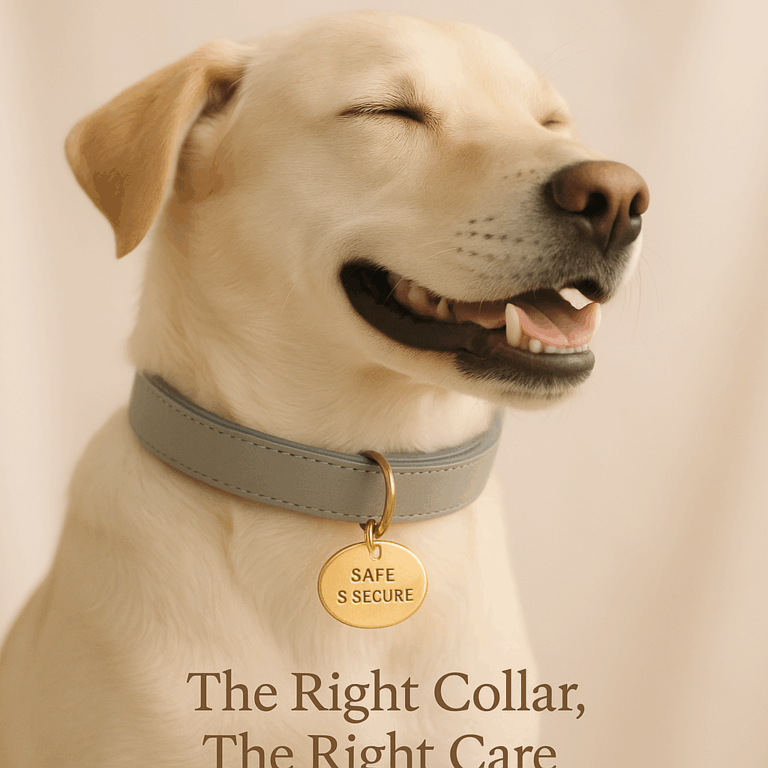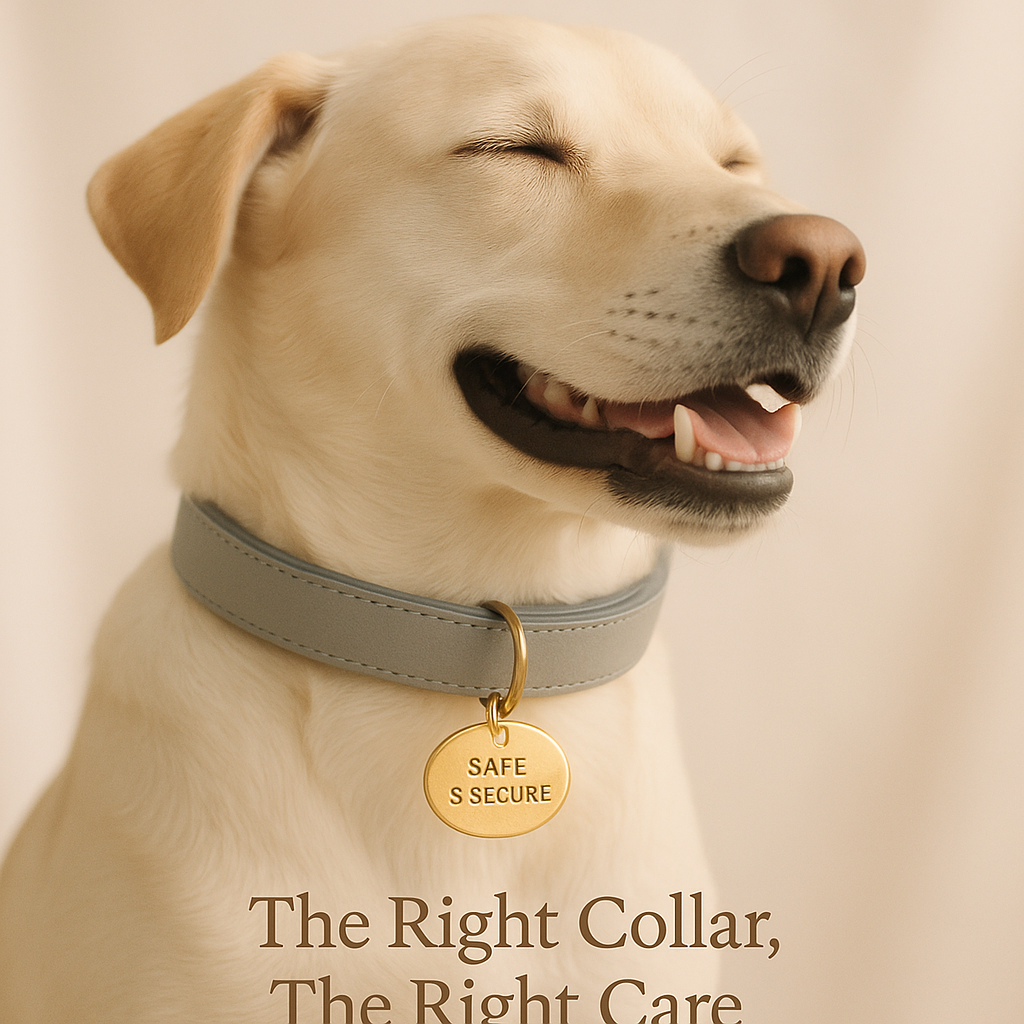Why Every Dog Deserves the Perfect Collar and ID Tag
Let’s talk about something that’s as essential to your dog’s safety as their daily walk and cuddle sessions: the dog collar and ID tag combo. If you’ve ever found yourself staring at a mountain of collars in a pet store, wondering which one’s right for your furry sidekick, you’re not alone. Choosing the right dog collar isn’t just about style (although we all want our pups to look fab); it’s about ensuring their safety, comfort, and yes, even their health.
The Collar: More Than Just a Pretty Accessory

Think of your dog collar as the first line of defense in pet care. It’s what holds the leash when you’re out strolling around the neighborhood, but its role goes far beyond that. A well-fitted collar can prevent your puppy from slipping out and sneaking off on an unintended solo adventure. It also helps distribute pressure evenly during walks, which is especially important for breeds prone to respiratory issues, like Pugs or Dachshunds.
Material matters here too. Neoprene collars are soft and waterproof—great for dogs who love their water play. Leather collars age beautifully and offer durability, but remember, they need regular conditioning to keep them from drying out and cracking. Nylon collars come in endless designs and colors and are typically lighter, making them a great choice for active dogs.
Here’s a quick tip from my trainer’s toolbox: When picking a collar, aim to fit two fingers snugly between the collar and your dog’s neck. Too tight, and it can cause discomfort or even injury; too loose, and you risk your dog slipping out.
The Essential ID Tag: Your Dog’s Digital Lifeline
Now, onto the tiny hero dangling from your dog’s collar—an ID tag. This little piece of metal (or high-tech alternative) can reunite you with your dog faster than you might imagine. According to the American Humane Association, nearly 15% of pets get lost at some point. Having a visible ID tag can be the difference between a quick reunion and weeks of frantic searching.
Traditionally, an ID tag contains your dog’s name, your phone number, and sometimes your address. But today’s ID tags have leveled up. Enter the era of smart ID tags—some come with QR codes that link directly to your pet’s profile with medical history, feeding schedule, and emergency contacts. Others use Bluetooth tech to alert you if your dog strays beyond a designated range. And yes, these gadgets still look cute dangling from your dog collar!
If you’re debating between a standard engraved tag and a smart one, consider your lifestyle. For urban pups who roam bustling streets or park adventures, a smart tag offers peace of mind. If your dog’s outings are more controlled or low-key, a classic engraved tag does the job beautifully.
Keeping It Comfy and Safe: Alternatives and Add-Ons
Choke chains and prong collars often come up in discussions among dog trainers, but let’s be clear—they’re not first-choice tools for everyday pet care, especially for puppies or nervous dogs. Positive reinforcement training paired with a well-fitted flat collar or a harness does wonders for behavior without risking injury.
Harnesses deserve a shout-out here too. Perfect for dogs with respiratory sensitivities or those who pull on the leash, harnesses distribute pressure across the chest and shoulders instead of the neck. Many harnesses come with built-in ID tag holders, making it easy to keep vital information close.
And for those who love style and safety combined, reflective collars and tags exist to keep your dog visible during early morning or late-night walks. Some even feature LED lights synced with your smartphone, turning a simple walk into a mini light show for you and your pup.
Keeping That Collar Fresh: Pet Care Tips You’ll Love
Let’s not forget: collars and ID tags need regular TLC too. Dirt, sweat, and grime build up can cause skin irritation or microbial infections, especially in puppies with sensitive skin. Regularly taking off your dog’s collar and gently cleaning it not only keeps your pet comfortable but also extends the life of the collar itself.
For metal ID tags, a quick polish with a soft cloth prevents tarnishing, and for smart tags, remember to check batteries periodically—nothing’s worse than discovering the “Find My Dog” feature isn’t working when you need it most.
During grooming sessions, it’s a good idea to check around your dog’s neck for any signs of rubbing or hair loss caused by their collar. Adjust as needed, and if your dog’s outgrown their collar, it’s time to upgrade.
Real Talk: When a Collar Saves the Day
Let me share a quick story from my training days that still warms my heart. One spirited Labrador puppy named Max loved to chase squirrels—and one day, he followed them a bit too far. Luckily, Max wore a smart ID tag with real-time location tracking. When his frantic owner called, the tag’s app pinpointed Max lounging under a big oak tree about a half-mile away. Rescue was swift, and Max never had a chance to get uneasy or wander further.
This is why I’m absolutely passionate about pairing every dog with the right collar and ID tag. We spend so much time training our pups to respond to “come!” but life happens, and a collar becomes a critical safety net.
Wrap Up Your Walk With Confidence
Choosing a dog collar and ID tag isn’t a one-size-fits-all affair. Think of it as part of your dog’s unique style and safety system tailored to their breed, size, behavior, and daily activities. Regular checks, comfy fits, and tech-savvy tags can make a world of difference, transforming a potential emergency into a quick, joyful reunion.
Next time you clip on your dog’s leash, take a moment to admire that collar and ID tag—it’s more than just fashion; it’s a love letter of safety, care, and endless adventures wrapped into one. Happy walking, fellow dog lovers!
Tags: best dog collar, choosing dog collar, comfortable dog collar, dog collar, dog collar health benefits, dog collar styles, dog identification, dog safety, ID tag, pet safety accessories